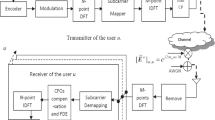Abstract
Although a code-division multiple-access (CDMA) system is spectrally efficient and has some immunity against intentional reception, its capacity and performance are generally limited by multiple access interference (MAI) caused by other users. For an aperiodic CDMA system, the spreading sequences span multiple symbol intervals, and the cross-correlations between these sequences, which are a measure of the MAI, are periodic over multiple symbols. In this paper, we present a receiver with a parallel architecture that converts an aperiodic CDMA sequence into a piecewise periodic sequence in each arm. We refer to this receiver as a cyclodespreader because the despreader exploits the cyclostationary property of an aperiodic signal. As a result, the transmitted data can be detected separately in each arm of the receiver using low-complexity conventional algorithms proposed for periodic CDMA systems. The goal of the receiver is to decode several signals received from different cochannel base stations. The performance of the system is evaluated using real aperiodic CDMA signals, and it is compared to that of a conventional matched filter (MF) receiver using the number of correctly decoded messages as the performance measure.
Similar content being viewed by others
References
Dahlman E., Beming P., Knutsson J., Ovesjo F., Persson M., Roobol C. (1998). WCDMA - The radio interface for future mobile multimedia communications. IEEE Transactions on Vehicular Technology 47, 1105–1118
Miller S.L. (1995). An adaptive direct-sequence code-division multiple-access receiver for multiuser interference rejection. IEEE Transactions on Communications 43, 1746–1755
Madhow U., Honig M.L. (1994). MMSE interference suppression for direct-sequence spread-spectrum CDMA. IEEE Transactions on Communications 42, 3178–3188
Honig M.L., Madhow U., Verdu S. (1995). Blind adaptive multiuser detector. IEEE Transactions on Information Theory 41, 944–960
Li, T., Tugnait, J. K., & Ding, Z. (2003). Channel estimation of long-code CDMA systems utilizing transmission induced cyclostationarity. In Proceedings of the IEEE International Conference on Acoustics, Speech, and Signal Processing, pp. 105–108. Hong Kong.
Chockalingam, A., Kumar, K. R. S., & Milstein, L. B. (2000). Performance of an LMS type receiver for interference suppression in long code DS-CDMA on Rayleigh fading channels. In Proceedings of the IEEE International Conference on Communications, pp. 1588–1592. New Orleans, LA.
Widrow B., Stearns S.D. (1985). Adaptive Signal Processing. Englewood Cliffs, NJ, Prentice-Hall
Venkataraman, V., Shynk, J. J., & Gooch, R. P. (2004). A cyclostationary receiver for aperiodic CDMA signals. In Proceedings of the Thirty-Eighth Asilomar Conference on Signals, Systems, and Computers, pp. 923–927. Pacific Grove, CA.
Wang X., Poor H.V. (1998). Blind adaptive multiuser detection in multipath CDMA channels based on subspace tracking. IEEE Transactions on Signal Processing 46, 3030–3044
Roy S. (2000). Subspace blind adaptive detection for multiuser CDMA. IEEE Transactions on Communications 48, 169–175
Honig, M. L. (1997). A comparison of subspace adaptive filtering techniques for DS-CDMA interference supression. In Proceedings of the IEEE Military Communications Conference, pp. 836–840. Monterey, CA.
Tikhonov A.N., Arsenin V.Y. (1977). Solutions of Ill-posed Problems. New York, Wiley
Carlson B.D. (1988). Covariance matrix estimation errors and diagonal loading in adaptive arrays. IEEE Transactions on Aerospace and Electronic Systems 24, 397–401
Madhow U. (1998). Blind adaptive interference suppression for direct-sequence CDMA. Proceedings of the IEEE 86, 2049–2069
Rugini L., Banelli P., Cacopardi S. (2005). A full-rank regularization technique for MMSE detection in multiuser CDMA systems. IEEE Communications Letters 9, 34–36
Garg, V. K. (2000). IS-95 CDMA and cdma2000: Cellular/PCS Systems Implementation. Upper Saddle River, NJ: Prentice-Hall.
Golub G.H., Hansen P.C., O’Leary D.P. (1999). Tikhonov regularization and total least squares. SIAM Journal on Matrix Analysis and Applications 21, 185–194
Kasparis, C., Piechocki, R. J., Fletcher, P. N., & Nix, A. R. (2003). A bootstrap multi-user detector for CDMA based on Tikhonov regularization. In Proceedings of the IEEE International Conference on Acoustics, Speech, and Signal Processing, pp. 69–72. Hong Kong.
Haykin S. (1996). Adaptive Filter Theory. 3rd edn. Upper Saddle River, NJ, Prentice-Hall
Lupas R., Verdu S. (1989). Linear multiuser detectors for synchronous code-division multiple access channels. IEEE Transactions on Information Theory 35, 123–136
Godard D.N. (1980). Self-recovering equalization and carrier tracking in two-dimensional data communication systems. IEEE Transactions on Communications 28, 1867–1875
Yi, W., Cunwu, H., & Weiling, W. (1999). Constrained constant modulus algorithm in multiuser detection. In Proceedings of the Fifth Asia-Pacific Conference on Communications, pp. 755–757. Beijing, China.
Treichler J.R., Johnson C.R., Jr., Larimore M.G. (1987). Theory and Design of Adaptive Filters. New York, Wiley
Verdu S. (1998). Multiuser Detection. New York, Cambridge University Press
Patel P., Holtzman J. (1994). Analysis of a simple successive interference cancellation scheme in a DS/CDMA system. IEEE Journal on Selected Areas in Communications 12, 796–807
Brown D.R., III, Motani M., Veeravalli V.V., Poor H.V., Johnson C.R., Jr. (2001). On the performance of linear parallel interference cancellation. IEEE Transactions on Information Theory 47, 1957–1970
Venkataraman, V., Shynk, J. J., & Gooch, R. P. (2005). A multistage interference canceler for detecting low-power aperiodic CDMA signals. In Proceedings of Conference on Information Sciences and Systems. Baltimore, MD.
Stark H., Woods J.W. (2001). Probability and Random Processes with Applications to Signal Processing. 3rd edn. Upper Saddle River, NJ, Prentice-Hall
Author information
Authors and Affiliations
Corresponding author
Rights and permissions
About this article
Cite this article
Venkataraman, V., Shynk, J.J. & Gooch, R.P. A Cyclodespreader Architecture for Detecting Multiple Downlink Aperiodic CDMA Signals. Wireless Pers Commun 43, 1553–1567 (2007). https://doi.org/10.1007/s11277-007-9326-8
Received:
Accepted:
Published:
Issue Date:
DOI: https://doi.org/10.1007/s11277-007-9326-8




